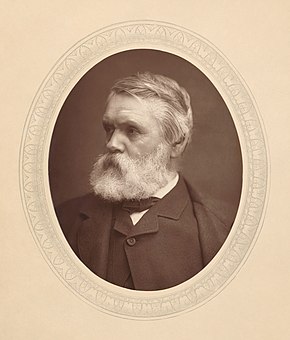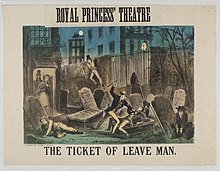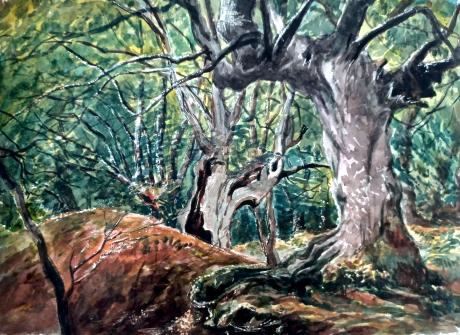inscribed and dated "Burnham Beeches Sunday Sept 12th 1858" and signed with initials "TT"
Tom and Laura Taylor and thence by descent
Burnham Beeches is a 374.6-hectare (926-acre) biological Site of Special Scientific Interest situated west of Farnham Common in the village of Burnham, Buckinghamshire. The southern half is owned by the Corporation of London and is open to the public. It is also a National Nature Reserve and a Special Area of Conservation.
Burnham Beeches came into ownership of the City of London Corporation after the land came up for auction in 1879. The auction followed the death of the land owner who had permitted public access. It's special status was recognised and discussed in the House of Commons. The land failed to sell at the auction. Subsequently Sir Henry Peek purchased the land at the reserve price £12,000. Sir Henry Peek sold 374 acres (151 hectares) to the City of London Corporation (£6,000), retaining the "enclosed" portion of the land of 175 acres (71 hectares). Purchase was funded from duties levied on grain landed at the Port of London. Money was also spent on roads to improve access (estimated cost £500), one of these is named after Sir Henry. At this time local authorities were encouraged to provide open spaces with public access to provide some relief from polluted towns and cities. (Summarised from Hansard and various contemporary newspaper reports.)

The largely beech woodland has been regularly pollarded, with many trees now several hundred years old. Their age, and the amount of deadwood in and around them, means that the woodland is rich in wildlife. More than sixty of the species of plants and animals here are either rare or under threat nationally. The area is protected as a National Nature Reserve, Site of Special Scientific Interest and a candidate Special Area of Conservation.
Seven Ways Plain hill fort is located in the south west part of Burnham Beeches. it is a rare example of a single rampart earthwork used either as a stock enclosures or possibly places of refuge. It comprises a range of earthworks which have been dated to the Late Bronze Age and Early Iron Age. It is a Scheduled Monument.
The close proximity of Pinewood, Shepperton and Bray Studios and the outstanding natural beauty of the Beeches have made it a desirable filming location. Robin Hood Prince of Thieves, The Crying Game, First Knight, Goldfinger, The Princess Bride, the 1952 Disney film The Story of Robin Hood and His Merrie Men, Harry Potter and the Order of the Phoenix and Harry Potter and the Deathly Hallows – Part 1, Maleficent: Mistress of Evil, Horrible Histories: The Movie, and the Doctor Who story State of Decay are some of the films and TV productions that have been shot at Burnham Beeches.
Filming is tightly controlled in recognition of the Beeches' international importance for wildlife. Filming is restricted to no more than twenty days per year and to certain times of year. Filming in environmentally sensitive areas has also been banned. Revenue from filming goes directly to fund the upkeep and management of the Beeches.
The historic Burnham Beeches have been described as one of the finest surviving woodland tracts anywhere in Britain, with a particular history of pollarding - the removal of timber from growing trees.
In the Domesday Book, the manor of Burnham is recorded as belonging to 'Walter, son of Other'. Upon Walter's demise, his son William took possession of the manor, as well as a new soon-to-be auspicious surname -- Windsor. The manor remained in the family's possession until 1204, when it was split between two new owners. An abbey was founded there in 1266, and in 1271 the abbess was granted a formal market, to take place on Thursdays. Strategically situated between London, Oxford and Bath, Burnham was ideally situated to take advantage of through traffic between the major towns, with the abbey often taking on the role of overnight resting station. The commerce brought with these travellers turned Burnham from a village into a bustling town, which it remained until the building of a bridge in neighboring Maidenhead, when that town began to prosper at Burnham's expense.
The historic parish church of St Peter can be found off the Burnham's High St, an ancient building with a fine 13th century tower that also boasts several wonderful stained glass pieces. Burnham Abbey also still stands, possibly thanks to being briefly owned by William Tyndale (1495-1536), the man who translated the Bible into English.
The Beeches are north of the village, reached via Hogfair Lane to the left of the High Street, then left into Britwell Rd and left once more onto Grove Road, which will eventually lead right into the ancient woodland. From there, one can either delve left onto Pumpkin Hill, or right, passed the office building and into the Lord Mayor's Drive (with the enigmatically named Druid's Oak on the right-hand side) or continue on the peripheral road -- Hawthorn Lane. The average age of the pollarded trees is estimated to be well in excess of 400 years. The largest tree, probably also the oldest, is the "Druid's Oak" -- almost certainly greater than 800 years old.
At 540 acres, the interior of the Beeches offers many easy walks as well as chances for some sly comparisons to the locations of many comparatively recent movies. Burnham Beeches is in fact a favorite location shoot, having stood in for Sherwood Forest in Robin Hood, Prince of Thieves, an Irish woodland in The Crying Game, ancient generic England in First Knight and Ivanhoe, and even a more tropical setting in A Town Like Alice. Off to the left of Park Lane lies Dorney Wood, a favorite haunt of footpads during the reign of Henry VIII. The entire area around Burnham was inundated with highwaymen during the Middle Ages, so much so that it was said that the Vicar of nearby Hurley got danger money for riding through the region. Further along on the right is a convenient parking area for those interested in viewing Hardicanute's Moat, a diamond-shaped earthwork of unknown origin.
In the far north-west corner of Burnham Beeches is the hamlet of Egypt. Why it was christened after the country in Northern Africa is also lost in history, but this pleasant little hamlet is another attractive reason to tarry awhile around the Buckinghamshire/Berkshire border.
The Burnham Beeches are the remnants of a vast forest that once covered almost the entire county of Buckinghamshire.
It is owned and managed by the Corporation of London who, in 1880, bought the woodland to save it from prospective developers.
Bounded by Windsor, Maidenhead and Slough, Burnham Beeches are within the area around London protected from further encroachment by the Green Belt. The Beeches, covering 220 hectares, are famous for ancient beech and oak pollards and the range of flora and fauna associated with old trees and decaying wood. It is a National Nature Reserve (NNR) and European Special Area of Conservation (SAC), famous for having the largest collection of old beech trees in the world.
Much of Burnham Beeches was once wood pasture. Cut in the past for wood fuel for local use, the site’s pollarded trees were abandoned approximately 200 years ago, resulting in very heavy branches on fragile stems. Many of the estimated 3,000 original trees have been lost as they have fallen over or fallen apart so now only around 420 remain. The City of London is working to re-establish the ancient techniques and restoring the old, lapsed pollards, as well as finding out new methods to create new pollards to help bridge the gap with the veterans.
The average age of the pollarded trees is estimated to be well in excess of 400 years. The largest tree, probably also the oldest, is the "Druid's Oak" -- almost certainly greater than 800 years old.
At 540 acres, the interior of the Beeches offers many easy walks as well as the chance to spot the locations of many movies and TV productions, as Burnham Beeches is a favourite location shoot, having stood in for Sherwood Forest in Robin Hood, Prince of Thieves, an Irish woodland in The Crying Game, ancient generic England in First Knight and Ivanhoe, and even a more tropical setting in A Town Like Alice.
The entire area was the haunt of highwaymen during the Middle Ages, so much so that it was said that the Vicar of nearby Hurley got danger money for riding through the region. One of the three Scheduled Ancient Monuments on the site shows inhabitation as early as the Iron Age. Hardicanute's Moat is a diamond-shaped earthwork of unknown origin.
Gnarled beeches, natural ponds and abundant wildlife create what has been described as a fairy tale-like atmosphere - particularly in autumn.
Visitor numbers to Burnham Beeches are currently regarded as unsustainably high, and this is causing substantial damage to this unique ancient woodland. To help protect the National Nature Reserve, the amount of available car parking has been reduced.

Tom Taylor (19 October 1817 – 12 July 1880) was an English dramatist, critic, biographer, public servant, and editor of Punch magazine. Taylor had a brief academic career, holding the professorship of English literature and language at University College, London in the 1840s, after which he practised law and became a civil servant. At the same time he became a journalist, most prominently as a contributor to, and eventually editor of Punch.
In addition to these vocations, Taylor began a theatre career and became best known as a playwright, with up to 100 plays staged during his career. Many were adaptations of French plays, but these and his original works cover a range from farce to melodrama. Most fell into neglect after Taylor's death, but Our American Cousin (1858), which achieved great success in the 19th century, remains famous as the piece that was being performed in the presence of Abraham Lincoln when he was assassinated in 1865.
Early years
Taylor was born into a newly wealthy family at Bishopwearmouth, a suburb of Sunderland, in north-east England. He was the second son of Thomas Taylor (1769–1843) and his wife, Maria Josephina, née Arnold (1784–1858). His father had begun as a labourer on a small farm in Cumberland and had risen to become co-owner of a flourishing brewery in Durham. After attending the Grange School in Sunderland, and studying for two sessions at the University of Glasgow, Taylor became a student of Trinity College, Cambridge in 1837, was elected to a scholarship in 1838, and graduated with a BA in both classics and mathematics. He was elected a fellow of the college in 1842 and received his MA degree the following year.

Taylor left Cambridge in late 1844 and moved to London, where for the next two years he pursued three careers simultaneously. He was professor of English language and literature at University College, London, while at the same time studying to become a barrister, and beginning his life's work as a writer. Taylor was called to the bar of the Middle Temple in November 1846. He resigned his university post, and practised on the northern legal circuit until he was appointed assistant secretary of the Board of Health in 1850. On the reconstruction of the board in 1854 he was made secretary, and on its abolition in 1858 his services were transferred to a department of the Home Office, retiring on a pension in 1876.
Writer
Taylor owed his fame and most of his income not to his academic, legal or government work, but to his writing. Soon after moving to London, he obtained remunerative work as a leader writer for the Morning Chronicle and the Daily News. He was also art critic for The Times and The Graphic for many years. He edited the Autobiography of B. R. Haydon (1853), the Autobiography and Correspondence of C. R. Leslie, R.A. (1860) and Pen Sketches from a Vanished Hand, selected from papers of Mortimer Collins, and wrote Life and Times of Sir Joshua Reynolds (1865). With his first contribution to Punch, on 19 October 1844, Taylor began a thirty-six year association with the magazine, which ended only with his death. During the 1840s he wrote on average three columns a month; in the 1850s and 1860s this output doubled. His biographer Craig Howes writes that Taylor's articles were generally humorous commentary or comic verses on politics, civic news, and the manners of the day. In 1874 he succeeded Charles William Shirley Brooks as editor.
Taylor also established himself as a playwright and eventually produced about 100 plays. Between 1844 and 1846, the Lyceum Theatre staged at least seven of his plays, including extravanzas written with Albert Smith or Charles Kenney, and his first major success, the 1846 farce To Parents and Guardians. The Morning Post said of that piece, "The writing is admirable throughout – neat, natural and epigrammatic". It was as a dramatist that Taylor made the most impression – his biographer in the Dictionary of National Biography (DNB) wrote that in writing plays Taylor found his true vocation. In thirty-five years he wrote more than seventy plays for the principal London theatres.

A substantial portion of Taylor's prolific output consisted of adaptations from the French or collaborations with other playwrights, notably Charles Reade. Some of his plots were adapted from the novels of Charles Dickens or others. Many of Taylor's plays were extremely popular, such as Masks and Faces, an extravaganza written in collaboration with Reade, produced at the Haymarket Theatre in November 1852. It was followed by the almost equally successful To Oblige Benson (Olympic Theatre, 1854), an adaptation from a French vaudeville. Others mentioned by the DNB are Plot and Passion (1853), Still Waters Run Deep (1855) and The Ticket-of-Leave Man (based on Le Retour de Melun by Édouard Brisebarre and Eugène Nus), a melodrama produced at the Olympic in 1863.Taylor also wrote a series of historical dramas (many in blank verse), including The Fool’s Revenge (1869), an adaption of Victor Hugo's Le roi s'amuse (also adapted by Verdi as Rigoletto), 'Twixt Axe and Crown (1870), Jeanne d'arc (1871), Lady Clancarty (1874) and Anne Boleyn (1875). The last of these, produced at the Haymarket in 1875, was Taylor's penultimate piece and only complete failure. In 1871 Taylor supplied the words to Arthur Sullivan's dramatic cantata, On Shore and Sea.
Like his colleague W. S. Gilbert, Taylor believed that plays should be readable as well as actable; he followed Gilbert in having copies of his plays printed for public sale. Both authors did so at some risk, because it made matters easy for American pirates of their works in the days before international copyright protection. Taylor wrote, "I have no wish to screen myself from literary criticism behind the plea that my plays were meant to be acted. It seems to me that every drama submitted to the judgment of audiences should be prepared to encounter that of readers".

Many of Taylor's plays were extremely popular, and several survived into the 20th century, although most are largely forgotten today. His Our American Cousin (1858) is now remembered chiefly as the play Abraham Lincoln was attending when he was assassinated, but it was revived many times during the 19th century with great success. It became celebrated as a vehicle for the popular comic actor Edward Sothern, and after his death, his sons, Lytton and E. H. Sothern, took over the part in revivals.
Howes records that Taylor was described as "of middle height, bearded [with] a pugilistic jaw and eyes which glittered like steel". Known for his remarkable energy, he was a keen swimmer and rower, who rose daily at five or six and wrote for three hours before taking an hour's brisk walk from his house in Wandsworth to his Whitehall office.
Some, like Ellen Terry, praised Taylor's kindness and generosity; others, including F. C. Burnand, found him obstinate and unforgiving. Terry wrote of Taylor in her memoirs:
Most people know that Tom Taylor was one of the leading playwrights of the 'sixties as well as the dramatic critic of The Times, editor of Punch, and a distinguished Civil Servant, but to us he was more than this. He was an institution! I simply cannot remember when I did not know him. It is the Tom Taylors of the world who give children on the stage their splendid education. We never had any education in the strict sense of the word yet through the Taylors and others, we were educated.
Terry's frequent stage partner, Henry Irving said that Taylor was an exception to the general rule that it was helpful, even though not essential, for a dramatist to be an actor to understand the techniques of stagecraft: "There is no dramatic author who more thoroughly understands his business".
In 1855 Taylor married the composer, musician and artist Laura Wilson Barker (1819–1905). She contributed music to at least one of his plays, an overture and entr'acte to Joan of Arc (1871), and harmonisations to his translation Ballads and Songs of Brittany (1865). There were two children: the artist John Wycliffe Taylor (1859–1925) and Laura Lucy Arnold Taylor (1863–1940). Taylor and his family lived at 84 Lavender Sweep, Battersea, where they held Sunday musical soirees. Celebrities who attended included Lewis Carroll, Charles Dickens, Henry Irving, Charles Reade, Alfred Tennyson, Ellen Terry and William Makepeace Thackeray.
Taylor died suddenly at his home in 1880 at the age of 62 and is buried in Brompton Cemetery. After his death, his widow retired to Coleshill, Buckinghamshire, where she died on 22 May 1905.

